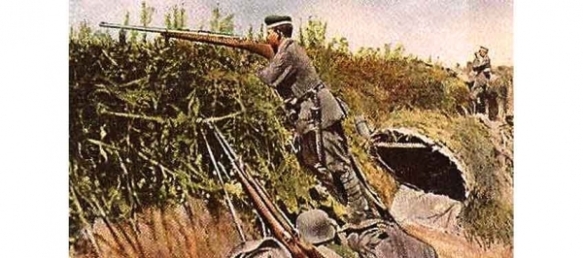After Cambrai the Germans naturally started to take AT defence much more seriously. The battle itself had shown some major aspects of AT defence which were pointers to the future.
The action at Flesquieres had shown how tanks were vulnerable to artillery in the direct fire mode, what would later be termed an ‘AT screen’, or ‘PAK front’, but should also have shown how vulnerable the AT screen was to artillery fire or air attack.
The fact that tanks could make no progress in Bourlon Wood or Fontaine showed how vulnerable they were in close country. The German infantry, having driven off the British infantry, attacked the tanks at close range with AP ammunition and bundles of grenades. In Fontaine they attacked the roofs of the tanks from upstairs windows. In Bourlon Wood a design fault of the tanks proved disastrous. Many of the trees had been reduced to stumps, when a tank drove over one its belly plate bent upwards and snagged the fly wheel. This stalled the engine, which in the tactical conditions it was not possible to restart.
On the third day of the battle a new AT measure made itself felt, K flak (Kraftfahr-Fliegerabwehrkanone). These were AA guns, usually 57-mm, mounted on lorries, and they could be devastating against tanks. They had a very limited off-road mobility, but because of the poor communications of the day they were almost impossible to engage with artillery, and because the tanks were almost blind, they could not defend themselves against them. K flak claimed a total of 64 tanks. In future years this type of vehicle would be called a ‘tank destroyer’ and would be one of the principal AT weapons. At the time the British, at least, attached no particular significance to them.
The Germans quickly set to work to produce new AT weapons. The two main ones were an AT rifle and an AT gun. The rifle was really just a scaled up service rifle. It was of 13-mm calibre, big and heavy, unpopular and not very effective. The gun was small, 37-mm, cheap and handy. Its muzzle velocity was not that high but quite good enough for the thin armour of the tanks of the time. The plan was to deploy these guns in AT forts scattered in the battle zone.
The Germans made a start on developing AT mines, but did not get very far. They did, however improve on their field AT fortifications. Even before Cambrai, as has been seen, they had widened certain trenches to make them obstacles for tanks, but they also dug short trenches at right angles to the front and camouflaged them to make tank traps, pitfalls that the mammoth-like tanks would fall into. There were cases of streams being dammed to make inundations, and also the casting of concrete obstacles.
The Germans assumed that any significant Allied offensive would be led by tanks and they gave the fight against them priority, but this had an important indirect effect on the German defences. In order to have guns available for the direct fire role a large number was moved forward and dug in around the forward edge of the battle zone. Such guns were no longer available for normal artillery employment, and they suffered heavy casualties.
It could well be that the Germans had the measure of the tanks of 1918 and, if their army had not been worn away in the great Spring Offensive, they could have defeated a major tank-led offensive providing they had time to select the battlefield and prepare their defences. But after the failure of the Spring Offensive they fell back through a series of positions based on rivers, these being good AT obstacles. However rivers run in valleys which could be dominated by British artillery, and these positions crumbled one after the other.
